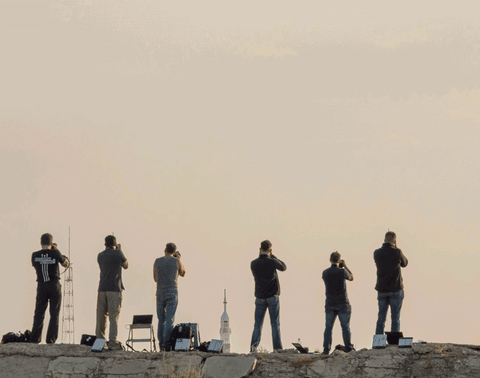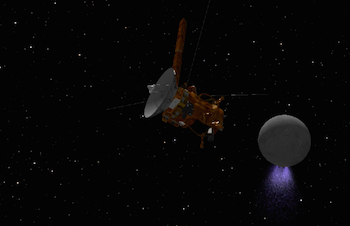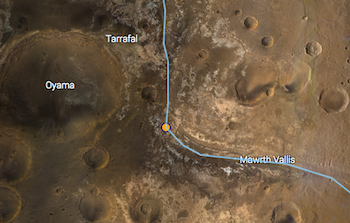LIFTOFF!

LIFTOFF!
On July 7, three crew members launched from Earth; headed to their new home on the International Space Station.
Crewmembers Kate Rubins of NASA, Anatoly Ivanishin of Roscosmos and Takuya Onishi of the Japan Aerospace Exploration Agency (JAXA) will spend approximately four months on the orbital complex, returning to Earth in October.
Photo Credit: (NASA/Bill Ingalls)
Make sure to follow us on Tumblr for your regular dose of space: http://nasa.tumblr.com
More Posts from Nasa and Others
Athletes Go for the Gold with NASA Spinoffs
NASA technology tends to find its way into the sporting world more often than you’d expect. Fitness is important to the space program because astronauts must undergo the extreme g-forces of getting into space and endure the long-term effects of weightlessness on the human body. The agency’s engineering expertise also means that items like shoes and swimsuits can be improved with NASA know-how.
As the 2024 Olympics are in full swing in Paris, here are some of the many NASA-derived technologies that have helped competitive athletes train for the games and made sure they’re properly equipped to win.

The LZR Racer reduces skin friction drag by covering more skin than traditional swimsuits. Multiple pieces of the water-resistant and extremely lightweight LZR Pulse fabric connect at ultrasonically welded seams and incorporate extremely low-profile zippers to keep viscous drag to a minimum.
Swimsuits That Don’t Drag
When the swimsuit manufacturer Speedo wanted its LZR Racer suit to have as little drag as possible, the company turned to the experts at Langley Research Center to test its materials and design. The end result was that the new suit reduced drag by 24 percent compared to the prior generation of Speedo racing suit and broke 13 world records in 2008. While the original LZR Racer is no longer used in competition due to the advantage it gave wearers, its legacy lives on in derivatives still produced to this day.

Trilion Quality Systems worked with NASA’s Glenn Research Center to adapt existing stereo photogrammetry software to work with high-speed cameras. Now the company sells the package widely, and it is used to analyze stress and strain in everything from knee implants to running shoes and more.
High-Speed Cameras for High-Speed Shoes
After space shuttle Columbia, investigators needed to see how materials reacted during recreation tests with high-speed cameras, which involved working with industry to create a system that could analyze footage filmed at 30,000 frames per second. Engineers at Adidas used this system to analyze the behavior of Olympic marathoners' feet as they hit the ground and adjusted the design of the company’s high-performance footwear based on these observations.

Martial artist Barry French holds an Impax Body Shield while former European middle-weight kickboxing champion Daryl Tyler delivers an explosive jump side kick; the force of the impact is registered precisely and shown on the display panel of the electronic box French is wearing on his belt.
One-Thousandth-of-an-Inch Punch
In the 1980s, Olympic martial artists needed a way to measure the impact of their strikes to improve training for competition. Impulse Technology reached out to Glenn Research Center to create the Impax sensor, an ultra-thin film sensor which creates a small amount of voltage when struck. The more force applied, the more voltage it generates, enabling a computerized display to show how powerful a punch or kick was.

Astronaut Sunita Williams poses while using the Interim Resistive Exercise Device on the ISS. The cylinders at the base of each side house the SpiraFlex FlexPacks that inventor Paul Francis honed under NASA contracts. They would go on to power the Bowflex Revolution and other commercial exercise equipment.
Weight Training Without the Weight
Astronauts spending long periods of time in space needed a way to maintain muscle mass without the effect of gravity, but lifting free weights doesn’t work when you’re practically weightless. An exercise machine that uses elastic resistance to provide the same benefits as weightlifting went to the space station in the year 2000. That resistance technology was commercialized into the Bowflex Revolution home exercise equipment shortly afterwards.
Want to learn more about technologies made for space and used on Earth? Check out NASA Spinoff to find products and services that wouldn’t exist without space exploration.
Make sure to follow us on Tumblr for your regular dose of space!

Hurry! You Can Catch a Ride to Jupiter with NASA
Well, at least your name can.
One of the planet Jupiter’s largest and most intriguing moons is called Europa. Evidence hints that beneath its icy shell, Europa hides an ocean of liquid water – more water than all of Earth’s oceans combined. In 2024, our Europa Clipper robotic spacecraft sets sail to take a closer look…and when it launches, your name can physically be aboard! Here’s how:
NASA’s Message in a Bottle campaign invites people around the world to sign their names to a poem written by the U.S. Poet Laureate, Ada Limón. The poem connects the two water worlds — Earth, yearning to reach out and understand what makes a world habitable, and Europa, waiting with secrets yet to be explored.

The poem will be engraved on Europa Clipper, along with participants' names that will be physically etched onto microchips mounted on the spacecraft. Together, the poem and names will travel 1.8 billion miles to the Jupiter system.

Signing up is easy! Just go to this site to sign your name to the poem and get on board. You can send your name en español, too. Envía tu nombre aquí.
The Europa Clipper launch window opens in October 2024, but don’t wait – everyone’s names need to be received this year so they can be loaded onto the spacecraft in time. Sign up by Dec. 31, 2023.
We hope you’ll be riding along with us! Follow the mission at europa.nasa.gov.
Make sure to follow us on Tumblr for your regular dose of space!
To the Moon and Beyond: Why Our SLS Rocket Is Designed for Deep Space
It will take incredible power to send the first woman and the next man to the Moon’s South Pole by 2024. That’s where America’s Space Launch System (SLS) rocket comes in to play.

Providing more payload mass, volume capability and energy to speed missions through deep space than any other rocket, our SLS rocket, along with our lunar Gateway and Orion spacecraft, creates the backbone for our deep space exploration and Artemis lunar mission goals.
Here’s why our SLS rocket is a deep space rocket like no other:
It’s a heavy lifter

The Artemis missions will send humans 280,000 miles away from Earth. That’s 1,000 times farther into space than the International Space Station. To accomplish that mega feat, you need a rocket that’s designed to lift — and lift heavy. With help from a dynamic core stage — the largest stage we have ever built — the 5.75-million-pound SLS rocket can propel itself off the Earth. This includes the 57,000 pounds of cargo that will go to the Moon. To accomplish this, SLS will produce 15% more thrust at launch and during ascent than the Saturn V did for the Apollo Program.
We have the power

Where do our rocket’s lift and thrust capabilities come from? If you take a peek under our powerful rocket’s hood, so to speak, you’ll find a core stage with four RS-25 engines that produce more than 2 million pounds of thrust alongside two solid rocket boosters that each provide another 3.6 million pounds of thrust power. It’s a bold design. Together, they provide an incredible 8.8 million pounds of thrust to power the Artemis missions off the Earth. The engines and boosters are modified heritage hardware from the Space Shuttle Program, ensuring high performance and reliability to drive our deep space missions.
A rocket with style

While our rocket’s core stage design will remain basically the same for each of the Artemis missions, the SLS rocket’s upper stage evolves to open new possibilities for payloads and even robotic scientific missions to worlds farther away than the Moon like Mars, Saturn and Jupiter. For the first three Artemis missions, our SLS rocket uses an interim cryogenic propulsion stage with one RL10 engine to send Orion to the lunar south pole. For Artemis missions following the initial 2024 Moon landing, our SLS rocket will have an exploration upper stage with bigger fuel tanks and four RL10 engines so that Orion, up to four astronauts and larger cargoes can be sent to the Moon, too. Additional core stages and upper stages will support either crewed Artemis missions, science missions or cargo missions for a sustained presence in deep space.
It’s just the beginning

Crews at our Michoud Assembly Facility in New Orleans are in the final phases of assembling the core stage for Artemis I— and are already working on assembly for Artemis II.
Through the Artemis program, we aim not just to return humans to the Moon, but to create a sustainable presence there as well. While there, astronauts will learn to use the Moon’s natural resources and harness our newfound knowledge to prepare for the horizon goal: humans on Mars.
Make sure to follow us on Tumblr for your regular dose of space: http://nasa.tumblr.com
how much (or are you at all) treated differently for being a women in your field? I know it’s a different experience for everyone and I just wanted to hear your perspective
Solar System: Top 5 Things to Know This Week
1. A Ceres of Fortunate Events

Our Dawn mission continues its exploration at Ceres, and the team is working with the data coming back to Earth, looking for explanations for the tiny world’s strange features. Follow Dawn’s expedition HERE.
2. Icy Moon Rendezvous

One of the most interesting places in the entire solar system is Saturn’s moon Enceladus, with its underground ocean and spectacular geyser plume. This month, the Cassini spacecraft will be buzzing close by Enceladus several times, the last such encounters of the mission. On October 14, Cassini will perform a targeted flyby at a distance of just 1,142 miles (1,838 kilometers) over the moon’s northern latitudes. Ride along with Cassini HERE.
3. Make Your Own Mars Walkabout

You can retrace Opportunity’s journey, see where the Curiosity rover is now, or even follow along with fictional astronaut Mark Watney from The Martian movie using the free online app MarsTrek. The app lets you zoom in on almost any part of the planet and see images obtained by our spacecraft, so you can plan your on Red Planet excursion. Take a hike HERE.
4. Elusive Features on Jupiter

New imagery from our Hubble Space Telescope is capturing details never before seen on Jupiter. High-resolution maps and spinning globes, rendered in the 4K Ultra HD format, reveal an elusive wave and changes to Jupiter’s Great Red Spot. Explore Jupiter HERE.
5. Mr. Blue Sky

Another week, another amazing picture from Pluto. The first color images of Pluto’s atmospheric hazes, returned by our New Horizons spacecraft last week, reveal that the hazes are blue. Who would have expected a blue sky in the Kuiper Belt? Most of the data collected during July’s Pluto flyby remains aboard the spacecraft, but the team publishes new batches of pictures and other findings on a weekly basis. Keep up with the latest HERE.
Make sure to follow us on Tumblr for your regular dose of space: http://nasa.tumblr.com

Ever wanted to look back in time? This week, we’re launching a kind of time machine – a telescope so powerful it will help us see back some of the first stars and galaxies made after the Big Bang.
The James Webb Space Telescope is the largest and most advanced telescope we’ve ever put in space. With revolutionary technology, it will study 13.5 billion years of cosmic history and help humanity understand our place in the stars.
Tomorrow, Dec. 25, at 7:20 a.m. ET (12:20 UTC), the Webb Telescope is set to launch from French Guiana, beginning a 29-day journey to a spot a million miles away.
How to Watch:
In English:
Dec. 25
Live coverage starts at 6:00 a.m. ET/11:00 UTC
Facebook, YouTube, Twitter, Twitch
In Spanish:
Dec. 25
Live coverage starts at 6:30 a.m. ET/11:30 UTC
Facebook, YouTube, Twitter
Once Webb launches, the journey has only just begun. The telescope will begin a 2-week-long process of unfolding itself in space before settling in to explore the universe in ways we’ve never seen before.
Follow along on Twitter, Facebook and Instagram and with #UnfoldTheUniverse.

The Roasted Planet
Can you hear this exoplanet screaming? As the exoplanet known as HD 80606 b approaches its star from an extreme, elliptical orbit, it suffers star-grazing torture that causes howling, supersonic winds and shockwave storms across this world beyond our solar system. Its torturous journey boils its atmosphere to a hellish 2,000 degrees Fahrenheit every 111 days, roasting both its light and dark sides. HD 80606b will never escape this scorching nightmare. Download this free poster in English and Spanish and check out the full Galaxy of Horrors.
Make sure to follow us on Tumblr for your regular dose of space!
Hello. I'm curious what new feature the james webb brings to the table, like its ability to detect in infrared, that you are most excited about? What are you most interested to look into with this new telescope?
Do you have any messages or tips for other girls who want to study and work in STEM fields?
Solar System: Things to Know
Help us find the most interesting spots to image on Jupiter, learn how Hubble is helping the Voyager craft find their way and more!
1. Calling All Citizen Scientists!

Join the Mission Juno virtual imaging team by helping us to determine the best locations in Jupiter's atmosphere that JunoCam will capture. Voting is open January 19-23, 2017. Visit www.missionjuno.swri.edu/junocam for more information about JunoCam voting.
2. Leading the Way

Our Hubble Space Telescope is providing a road map for the two Voyager spacecraft as they hurtle through unexplored territory on their trip beyond our solar system. Along the way, the Voyager craft are measuring the interstellar medium, the mysterious environment between stars. Hubble is measuring the material along the probes' future trajectories and even after the Voyagers run out of electrical power and are unable to send back new data, which may happen in about a decade, astronomers can use Hubble observations to characterize the environment of through which these silent ambassadors will glide.
3. Explorers Wanted

Mars needs YOU! In the future, Mars will need all kinds of explorers, farmers, surveyors, teachers . . . but most of all YOU! Join us on the Journey to Mars as we explore with robots and send humans there one day. Download a Mars poster that speaks to you. Be an explorer!
4. Tracking Every Sol

Each sol, or Martian day, the Mars Curiosity Team tracks the rover’s progress. And you can track them too at: http://mars.nasa.gov/msl/mission/mars-rover-curiosity-mission-updates/.
5. Happy 425th birthday, Pierre Gassendi

January 22 is the 425th birthday of Pierre Gassendi, French philosopher, priest, scientist, astronomer, mathematician and an active observational scientist. He was the first to publish data on the 1631 transit of Mercury. The Lunar Crater Gassendi is named for him.
Discover the full list of 10 things to know about our solar system this week HERE.
Make sure to follow us on Tumblr for your regular dose of space: http://nasa.tumblr.com
-
 chillypepperhot reblogged this · 7 months ago
chillypepperhot reblogged this · 7 months ago -
 thejoshlange liked this · 1 year ago
thejoshlange liked this · 1 year ago -
 frpost reblogged this · 1 year ago
frpost reblogged this · 1 year ago -
 frpost liked this · 1 year ago
frpost liked this · 1 year ago -
 bull-88a reblogged this · 1 year ago
bull-88a reblogged this · 1 year ago -
 bull-88a liked this · 1 year ago
bull-88a liked this · 1 year ago -
 4711-0815-00 liked this · 2 years ago
4711-0815-00 liked this · 2 years ago -
 chillypepperhot liked this · 2 years ago
chillypepperhot liked this · 2 years ago -
 gensha reblogged this · 3 years ago
gensha reblogged this · 3 years ago -
 mojomatao reblogged this · 3 years ago
mojomatao reblogged this · 3 years ago -
 bamio liked this · 3 years ago
bamio liked this · 3 years ago -
 diverdwon liked this · 3 years ago
diverdwon liked this · 3 years ago -
 what-a-fantastic-night reblogged this · 3 years ago
what-a-fantastic-night reblogged this · 3 years ago -
 what-a-fantastic-night liked this · 3 years ago
what-a-fantastic-night liked this · 3 years ago -
 peyman-akbari liked this · 3 years ago
peyman-akbari liked this · 3 years ago -
 famousstudentfox-f2b49400 reblogged this · 3 years ago
famousstudentfox-f2b49400 reblogged this · 3 years ago -
 two-men-in-love liked this · 3 years ago
two-men-in-love liked this · 3 years ago -
 melimelo85 reblogged this · 3 years ago
melimelo85 reblogged this · 3 years ago -
 tinmwky liked this · 3 years ago
tinmwky liked this · 3 years ago -
 freeangel462 reblogged this · 3 years ago
freeangel462 reblogged this · 3 years ago -
 chibikin liked this · 3 years ago
chibikin liked this · 3 years ago -
 shortcutss reblogged this · 3 years ago
shortcutss reblogged this · 3 years ago -
 timebornsea reblogged this · 3 years ago
timebornsea reblogged this · 3 years ago -
 nabarunbanerjee liked this · 3 years ago
nabarunbanerjee liked this · 3 years ago -
 icelolly liked this · 3 years ago
icelolly liked this · 3 years ago
Explore the universe and discover our home planet with the official NASA Tumblr account
1K posts